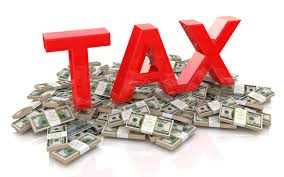A Short History Of Taxes
“In this world, nothing can be said to be certain, except death and taxes.” –Benjamin Franklin
Benjamin Franklin was correct in his assessment of both death and taxes, but while taxes have been certain, they’ve been far from consistent. America was tax-free for much of its early history. That is, free of direct taxation like income tax. It was, after all, taxes that led Americans to revolt against the British in 1773. Following the Revolutionary War, the new American government was understandably cautious when it came to taxation–direct taxation was prevented by the constitution for all practical purposes. Therefore, government revenues had to be collected through tariffs and duties on certain items. These excise taxes on liquor, tobacco, sugar, legal documents and so on betrayed a social agenda as well as a revenue gathering attempt. The first challenge to the system came in 1794, when the Whiskey Rebellion broke out. It was basically groups of Pennsylvanian farmers angry about the tax on whiskey burning down tax collectors’ houses and tarring and feathering any collectors too slow to get away. Defending the right to collect their indirect taxes, Congress put down the revolt by military force.
War Is Hell, but Taxes Last Longer
The sanctity of the constitution and the ancestral aversion to taxes was tested again in the 1790s, when a war with France led to a property tax. The implementation of this tax was far from perfect, so the later war of 1812 was funded by higher duties and excise taxes. It would take a Civil War to bring income tax into the young nation. The American Civil War was disastrous and expensive for the nation in that massive amounts of debt were incurred waging war against itself. In order to help pay for the war, the Congress passed the Revenue Act of 1861. The tax was levied on incomes exceeding $800 and was not rescinded until 1872. This act created most of what we consider the modern tax system. The U.S. Internal Revenue Service (IRS) was founded, the tax was progressive and some deductions were allowed.
Rewriting the Constitution
The Constitution forbade any direct taxes that were not levied in proportion to each state’s population. The Supreme Court declared a flat tax contained in the 1894 Wilson-Gorman Tariff Act unconstitutional in 1895. Although a victory for taxpayers, many people were beginning to note the damage that revenue-collecting tariffs and duties were having both on world trade and the living standards of the poor. So the 16th Amendment was introduced in 1913 to pave the way to an income tax by removing the proportional to population clause, thus saving the poor souls at the IRS from the unemployment line. It was quickly followed by an income tax on people with an annual income of over $3,000. This tax touched less than 1% of Americans. Interestingly, the phrase “lawful income” was later changed to simply “income” in 1916, thus giving prosecutors a way to convict organized crime figures such as Al Capone when all other avenues were exhausted.
World War, World Prosperity, World Depression
World War I led to three Revenue Acts that cranked up tax rates and lowered the exemption levels. The number of people paying taxes in the U.S. increased to 5%, and separate taxes were introduced for estates and excess business profits. These taxes were rolled back following the war in five phases, and the economy experienced a huge boom. Government tax receipts reached $3.6 billion in 1918, the last year of the war. Despite lowering taxes, the government take reached $6.6 billion in 1920. The crash of 1929 and the financial fallout saw these revenues fall to $1.9 billion by 1932.
Roosevelt and Rising Taxes
Roosevelt’s New Deal and WWII saw many taxes introduced or increased. The New Deal ran a heavy deficit that needed to be made up by revenue. By 1936 the top tax rate was a staggering 76% and the economy’s output plummeted. Taxes were raised several more times with the exception of the 1938 Revenue Act–it contained a corporate tax cut that Roosevelt objected to, but that nevertheless passed. By 1940, the need for the U.S. to prepare for war and support its allies led to even more aggressive taxation. People with incomes of $500 faced a 23% tax and the rates climbed up to 94%. By 1945 43 million Americans paid tax and the yearly receipts were in excess of $45 billion, up from $9 billion in 1941.
Nixon and Stagflation
The Revenue Act of 1945 rolled back $6 billion in taxes, but the burden of social security and an expanded government kept them from going much lower. Well into the ’50s, the highest tax rate was over 80% and the pay-as-you-go withholding system introduced as a wartime measure was never shut down. Progress in lowering taxes was sporadic and confusing. Rather than rolling back rates as such, the tax code was being rewritten to allow deductions in certain circumstances or to lower rates on, say, private foundations while raising rates on corporate profits. This explosion in loopholes and fine print is one reason most people today can master the theory of relativity before the tax code. The 1960s and ’70s were a time of massive inflation, and government deficits continued to grow as Medicare was added to the expensive social security system. Inflation turned out to be a huge problem for taxpayers because taxes weren’t indexed for it. This meant that although the real value of people’s income was being decreased, they were also required to pay more tax as bracket creep set in. The ’70s also saw President Nixon forced to pay over $400,000 in back taxes. With the controversy over the Watergate scandal, the president’s tax evasion wasn’t as big of an issue as it might have been.
Reaganomics
The Economic Recovery Tax Act of 1981 represented a turning of the tide for taxation, even though it was only temporary. Reagan lowered all the individual tax brackets by 25% and changed the way companies accounted for capital expenditures, encouraging investment in equipment. Simultaneously, Reagan sought to bring inflation under control and succeeded a little too well. The government’s budget was based on an accepted rate of inflation, and when the attempts to quash inflation kicked in too quickly, a deficit was created. Consequently, Reagan had to pare back some of his tax cuts in 1984, specifically on the corporate side, to try and make up the budget shortfall. Despite this, the IRS announced that in 1985 more than 400,000 Americans had reached the millionaire rank thanks to the high-level tax cuts under Reaganomics. In 1986 another tax reform act lowered the top rate from 50% to 28% and cut corporate tax from 50% to 35%. With more Americans now willing to take their wealth in taxable income, the overall tax receipts were relatively unchanged despite the drop.
The ’90s and Negative Tax
The Republicans did a lot to bring taxes under control, but their control over the size of government was less laudable. Medicare and Social Security were inherited burdens, but other expenditures were added to the bulging deficit. When Clinton came to power in the ’90s, the downward trend in taxes was at an end. 1993 saw modest increases in taxes and 1997 saw the introduction of negative income tax. Negative income tax was a hidden spending program whereby people who paid no tax could get funds through the tax system in the form of tax credits.
Bush and Beyond
The 2001 tax cut introduced by Bush once again dialed back the trend of tax increases but it continued to increase the tax credits that lead to negative income tax. Though not intended for it, this long-term tax cut helped shorten the recession following the dot-com crash, sparing the economy any specific stimulus measures. The Bush tax cuts expire in 2010 under a democratic government facing the retirement of the baby boomers and their expected strain on social programs. The intention to further expand the existing social programs and add free healthcare to boot make it very unlikely that U.S. taxpayers will see another downward trend for awhile. Bills must be paid, and it is we, the taxpayers, who end up paying them.

